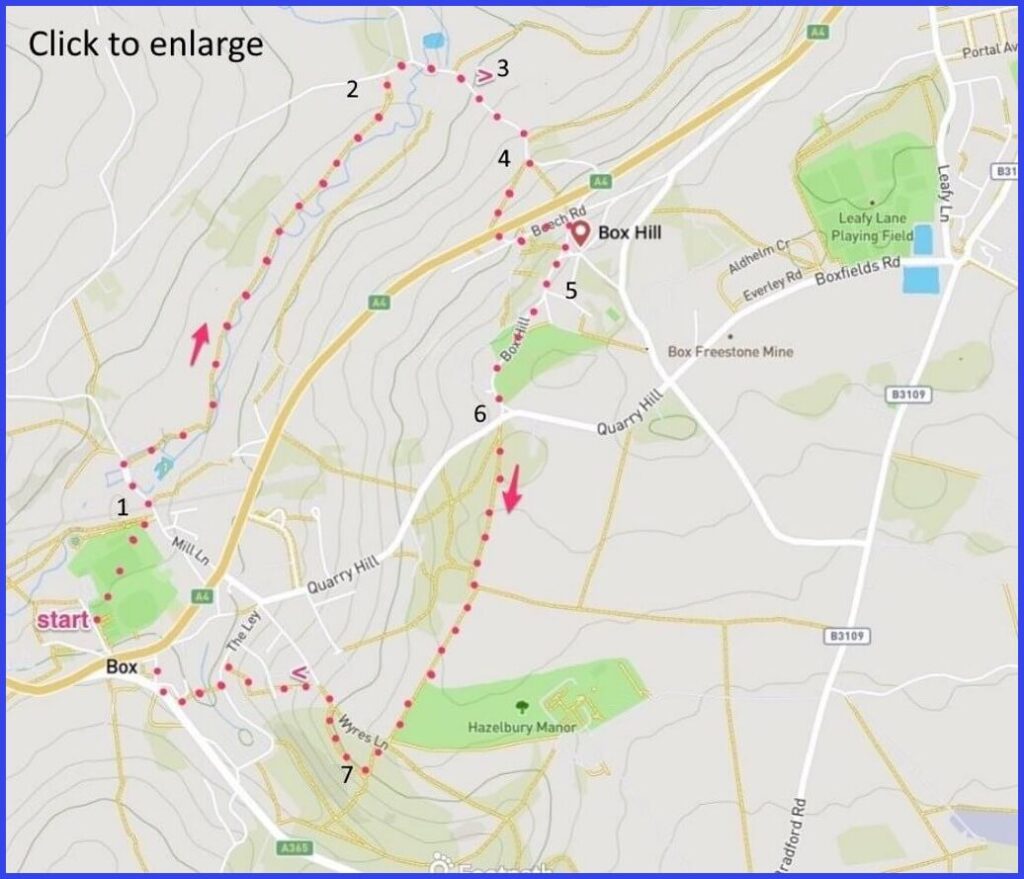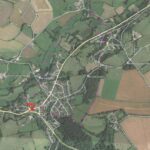(Routes from map points + metres to next point)
Start: Walk diagonally across the ‘rec’ to far corner, 280m
1 Turn left on road. Under railway. Take second footpath on right by entrance to studios. Enter open field and follow path alonside ByBrook to the far left corner. 1.3km
2 Turn right and follow road round rightwards. 130m
3 Pass Drewetts Mill and continue uphill on lane. 250m
4 After bridleway sign but before left bend, take path across field on right towards houses. Cross (busy) road to lane opposite. 550m
5 Follow Beech Road upwards until U-turn that veers right up to pub via Barretts Hill. 300m
6 Follow road round until seat on the left bank. Drop down right on Quarry hill and quickly take footpath on left through trees, keeping straight downwards. 870m
7 Choices here, most take you through housing ultimately towards main road, Queens Head pub and ‘rec’ behind. 500m
The pictures below are in the order things were seen on this walk. Clicking on any one will enlarge it (and the slideshow)
The walk
Here’s a summary: At point 1 you pass the Mill, converted by Peter Gabriel into Real World Studios. You then walk alongside the By Brook (a 12-mile tributary of the Avon) upon which a large number of Mills were built. Previously they were for corn grinding but later became ‘fulling mills’ for cleaning and thickening wool. The river ByBrook has a lot to do with Wiltshire’s mediaeval wealth from wool. The final part of the walk engages with another industrial history particularly distinctive to this area: quarrying.
Wool history
At Point 3, pass a group of buildings serving and including Drewett’s Mill with its long history (see Domesday Book). First involving grain processing and, later, the fulling process. Its still in use, driving two pairs of stones and a saw bench. For several centuries, the fulling mills made this part of Wiltshire one of the most important textile areas in the world. Originally, the spinning of wool had been a home industry – perhaps often done by unmarried women (“spinsters”). Afterwards, their work went to weavers. Then to cleaning and felting, which was done by ‘walkers’ (who might be called ‘fullers’ or ‘tuckers’). This stage required laborious and unpleasant treading work (don’t think ‘grapes’ – the process needed lots of urine). If a product was to go beyond the Wiltshire White (i.e. undyed) Broadcloth, there would need to be a final stage of dyers (slow to develop in Wilts).
The subsequent mechanisation of the fulling process (felting together woollen cloth) spread from the late twelfth century. It was taken over by mills in those (often small – like Box) wool communities with access to the necessary water power – sometimes converting existing corn mills to the fulling process. Drewett’s Mill may have been converted in this way (although later returned to grain processing). These buildings are now scarce in anything like their original design; they were the only significant industrial buildings of this important Wiltshire industry in its early days. Although, later, the industry did devise various machines, but these would reside alone in a wide variety of dwellings, albeit coming together as time went by in buildings resembling what we would now term ‘factories’.
Quarrying and tunnelling
The road towards point 5 is steep but is rewarded by the Quarrymans Arms where you can get good beer, good food and a good view (if you get a table near the picture window). It’s not obvious where the customers come from but it’s often quite busy – some using the al fresco seating out front. Although earlier custom would have come from the hamlet located here for families working the mine. Since then the land has been acquired as a common for the benefit of local people. Not sure it attracts may quarrymen though – couple at the next door table were talking about Jorge Louis Borges.
The road at point 6 has you walking over Brunel’s famous 2-mile Box railway tunnel. At peak construction 4000 navies and 300 horses worked at this. Over five years 30 million bricks were transported from Chippenham for lining. If it happens to be April 9th (Brunel’s birthday), you might drop down and check that the sun can be seen shining through the length of the tunnel.
The land to the left is the site of the famous Box freestone mine (‘freestone’, fossil free, can be cut in any direction without splitting). And the woods to the right are the site of the old entrance. The mine was worked in Roman times, gradually becoming the largest underground stone workings in the UK. It contributed to the honey-coloured stone of Bath architecture (why ‘honey’? its more peanut butter). The tunnels are closed now – largely because of a careless group who recently got trapped checking them out, although – thanks to mobile phones – they were safely rescued.
Freestone here was called ‘Hazelbury’ or ‘Box Ground’. The history of the mine is well told in a book by David Pollard called “Digging bath stone“. While the story of the Georgian families who operated the mill is told here. Some photos of work in the quarry after 1800 are here. Finally, you can get some sense of what is down there from this video.
Return to start
Before reaching point 7 a detour would be possible – which would take you to 14th century Hazelbury Manor, although its in private ownership, so you would only be able to wander round the strictly bordered grounds. The final part of the walk meanders through modern housing until you surface on the main road, where you can turn back into the village and perhaps stop in the Queens Head – an old pub that grew its outdoor provision in the pandemic and works hard to present local musicians.
However, you might notice the ‘Blind House‘ that is one side of its car park. There are a number of these in Wiltshire. They were prisons, usually short-term affairs – although sometimes the guests were awaiting further consideration. Given these ‘houses’ were usually windowless and might serve more than one occupant, this would not have been a good experience. Yet the Box one is unusually elegant.



![[A]](https://wiltshirewalks.com/wp-content/uploads/2021/10/01boxhill-150x150.jpg)
![[B]](https://wiltshirewalks.com/wp-content/uploads/2021/10/02boxhill-150x150.jpg)
![[C]](https://wiltshirewalks.com/wp-content/uploads/2021/10/03boxhill-150x150.jpg)
![[D]](https://wiltshirewalks.com/wp-content/uploads/2021/10/04boxhill-150x150.jpg)
![[E]](https://wiltshirewalks.com/wp-content/uploads/2021/10/05boxhill-150x150.jpg)
![[F]](https://wiltshirewalks.com/wp-content/uploads/2021/10/06boxhill-150x150.jpg)